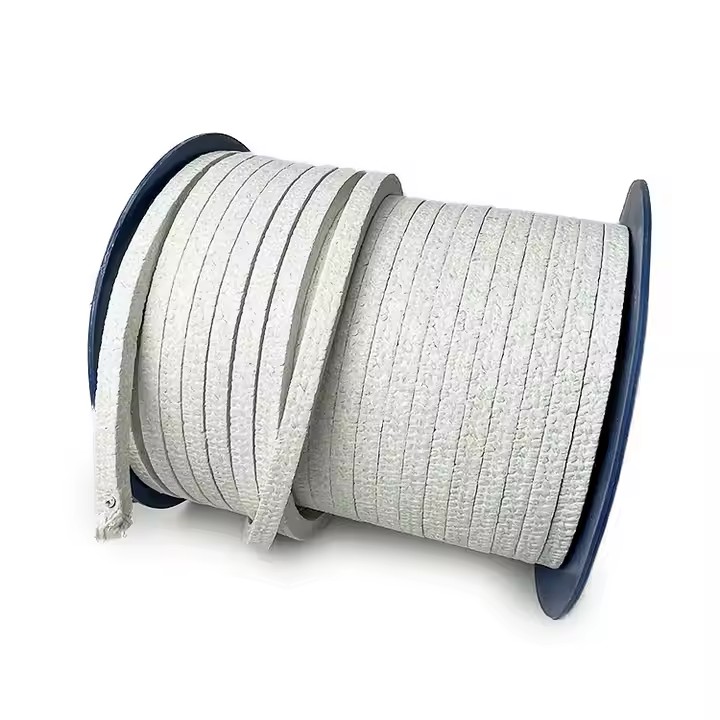Tetrafluoroethylene packing is a high-performance sealing material. It has extensive applications across various industries. There are major differences between PTFE packing with oil and PTFE packing without oil. They differ in their chemical composition, performance, and uses.
Chemical Composition:
1. Oil-free tetrafluoroethylene packing
a. Main Components: Manufacturers weave oil-free tetrafluoroethylene packing from polytetrafluoroethylene fibers. It contains no oily substances or additives.
b. A special weaving process makes PTFE fibers into a flexible, adjustable seal.
2. Oil-containing tetrafluoroethylene packing
a. Main Components: Oil-containing tetrafluoroethylene packing is based on PTFE fibers. It adds a suitable amount of lubricating oil, such as silicone oil, or other lubricants.
b. Processing Method: A lubricant is evenly infused into the PTFE fibers during or after weaving. This improves lubrication and sealing.
Performance Characteristics:
1. Oil-free Tetrafluoroethylene Packing
a. Chemical Stability: It has excellent stability. It resists corrosion by strong acids, strong bases, and organic solvents, per reports.
b. Thermal Stability: It can remain stable at high temperatures. It is typically used at -196°C to 260°C. The exact range may vary by product and process.
c. Electrical Insulation: It has good electrical insulation. It is suitable for uses needing electrical isolation.
d. Self-lubrication: It has no oil, but it is somewhat self-lubricating. It can reduce friction and wear between sealing surfaces.
e. Wear Resistance: PTFE fibers give oil-free tetrafluoroethylene packing good wear resistance.
f. Cleanliness: It does not produce oil stains during use. This helps to keep a clean environment.
2. Oil-containing tetrafluoroethylene packing
a. Lubrication: Adding lubricating oil or lubricants gives oil-containing tetrafluoroethylene packing good lubrication. It reduces friction between sealing surfaces, wear, and energy consumption to a large extent.
b. Better lubrication means better sealing. It is now suitable for high-seal applications.
c. Corrosion Resistance: The oil in the tetrafluoroethylene packing, despite the added oil, does not reduce its excellent corrosion resistance. It is still as good as PTFE.
d. Applicability: Oil-containing tetrafluoroethylene packing has better lubrication. It is better for sealing in harsh environments. These include high temperatures, high pressures, and strong corrosive conditions.
Application Scenarios:
1. Oil-free Tetrafluoroethylene Packing
a. Food Industry: Oil-free tetrafluoroethylene packing is widely used in food processing equipment. It is oil-free, clean, odorless, and meets hygiene standards.
b. Pharmaceutical Industry: Its clean, odorless, and hygienic qualities make it suitable for sealing equipment in the pharmaceutical industry.
c. Chemical Industry: For chemical equipment, use oil-free tetrafluoroethylene packing. It can handle corrosive media and has high cleanliness requirements.
d. Other Industries: Some papermaking and chemical fiber equipment use oil-free, tetrafluoroethylene packing for seals.
2. Oil-containing tetrafluoroethylene packing
a. In high-temperature, high-pressure applications, oil-containing tetrafluoroethylene packing is widely used. It has good lubrication and sealing performance.
b. Strong Corrosive Environments: In strong corrosive media, like in the chemical industry, equipment often uses oil-containing tetrafluoroethylene packing for sealing. This includes reaction vessels and agitators.
c. Dynamic Sealing: Oil-containing tetrafluoroethylene packing has good lubrication. So, it is better for dynamic seals with frequent start-stop operations.
Price Difference:
Oil-containing black tetrafluoroethylene packing may cost more. The added lubricants raise its production cost and price. Observe the notes.
1. Selecting the right packing: In practice, choose it based on the work environment. In clean environments, use oil-free PTFE packing. In high-temperature, high-pressure, or corrosive environments, use oil-impregnated PTFE packing.
2. Installation and maintenance: When installing PTFE packing, follow stable procedures. This ensures the sealing surface is flat and clean. Additionally, users should carry out regular inspections and maintenance during use. If sealing performance or leakage declines, replace it without delay.
3. Storage conditions: Store PTFE packing in a dry, ventilated, and dark place. Avoid contact with organic solvents, acids, alkalis, and other harmful substances.
 Hongwo Braided Packing
Hongwo Braided Packing




WhatsApp
Scan the QR Code to start a WhatsApp chat with us.